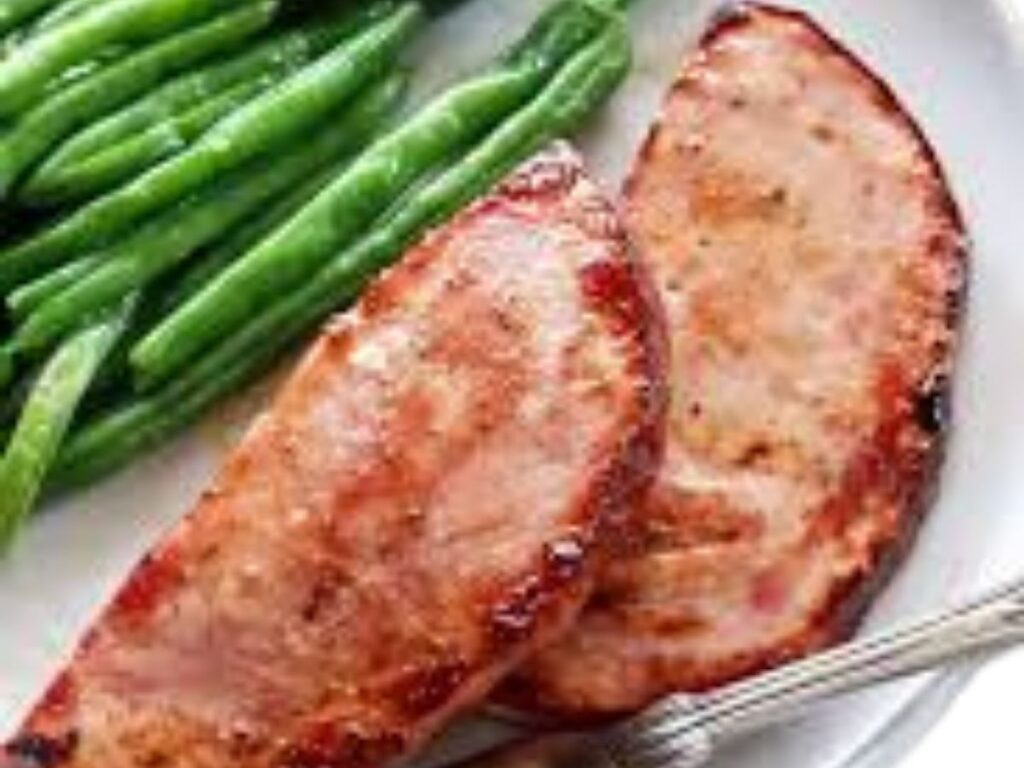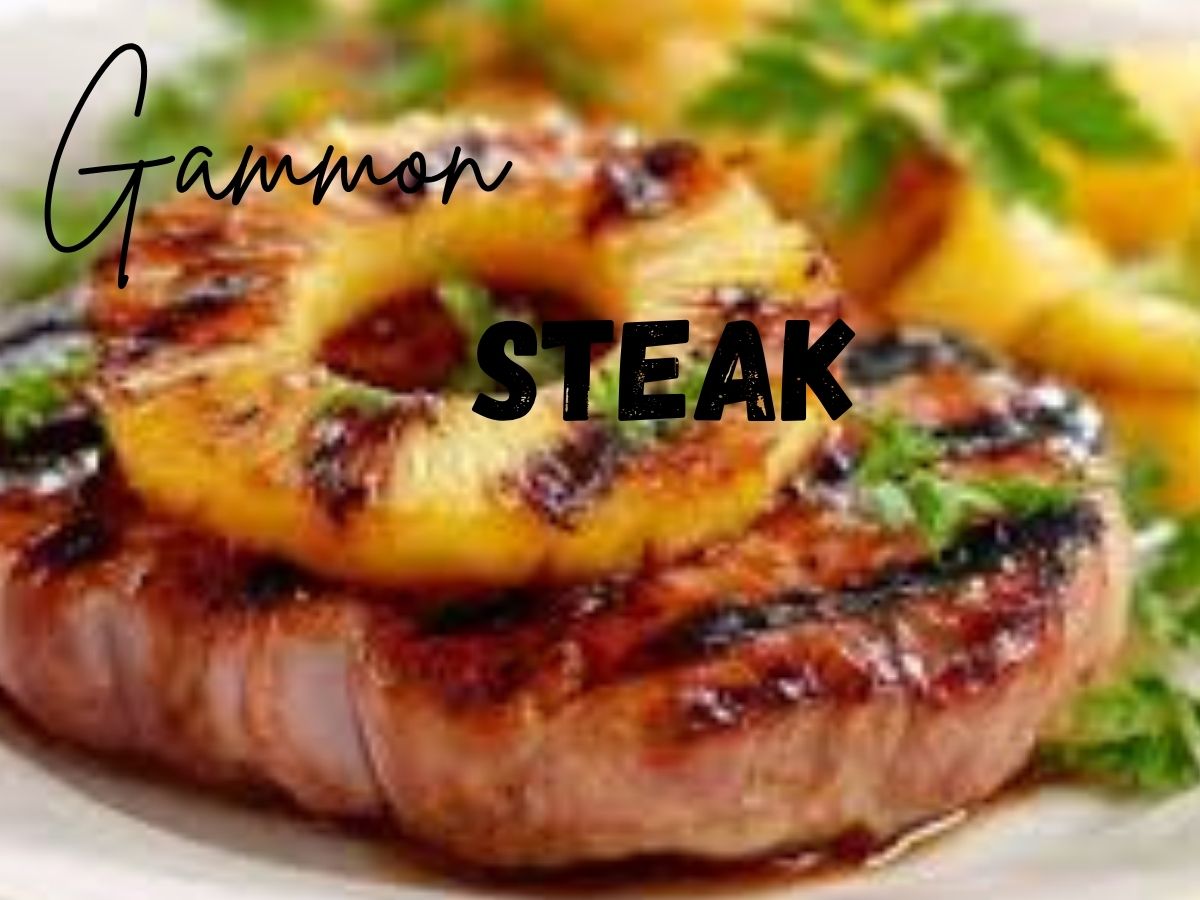There’s something wonderfully nostalgic about gammon steak that thick, juicy cut of cured pork sizzling in a pan, perhaps topped with a golden pineapple ring and a perfectly fried egg. It’s quintessentially British comfort food that brings back memories of cosy meals and family dinners where simple ingredients created pure satisfaction. The beautiful thing about gammon steak is how it straddles the line between everyday meal and special occasion dish, feeling both humble and celebratory at the same time.
Gammon steak, cut from cured pork leg, offers a unique flavour profile that sets it apart from regular pork chops or bacon. The curing process gives it that distinctive salty sweet taste and gorgeous pink colour, while proper cooking ensures tender, juicy meat that’s never dry or tough. Whether you’re a fan of the traditional gammon with pineapple combination, prefer it simply grilled with vegetables, or want to explore creative glazes and accompaniments, this versatile cut adapts beautifully to countless preparations.
This comprehensive guide covers everything you need to know about cooking gammon steaks to perfection. We’ll explore multiple cooking methods from classic pan frying to modern air fryer techniques along with flavour combinations that range from traditional British to international inspirations. You’ll discover how to avoid common pitfalls like overcooking or excessive saltiness, and learn the secrets to achieving that perfect caramelized exterior with a tender, succulent interior.
Recipe Overview
| Prep Time | 5 minutes |
| Cook Time | 12-15 min |
| Total Time | 20-24 min |
| Yield | 2 steaks (2 servings) |
| Difficulty Level | Easy |
| Cuisine | British |
This classic gammon steak recipe produces beautifully caramelized steaks with optional pineapple rings and fried eggs for the traditional presentation. The method works with any cooking technique pan, grill, oven, or air fryer and takes less than 25 minutes from start to finish. Gammon steaks are naturally flavorful and require minimal seasoning, making them perfect for quick weeknight dinners or leisurely weekend brunches.
The recipe is incredibly forgiving, accommodating various thicknesses of steak and different levels of desired caramelization. Whether you prefer your gammon lightly cooked with just a hint of colour or deeply caramelized with crispy edges, the basic technique remains the same with simple timing adjustments.
Ingredients
Classic Gammon Steak Recipe
For the Steaks:
- 2 gammon steaks (approximately 8 oz each, ½ to ¾ inch thick)
- 1 tablespoon olive oil or butter
- Freshly ground black pepper
- 2 pineapple rings (canned or fresh)
- 2 eggs (optional, for traditional serving)
For Glaze (Optional):
- 2 tablespoons honey or maple syrup
- 1 tablespoon wholegrain mustard
- 1 teaspoon apple cider vinegar
Understanding Gammon Steaks
What Makes Gammon Different:
- Cut from the hind leg of pork, then cured (usually with salt and sometimes sugar)
- Pre-cooked means it’s essentially “cooked” but needs heating through
- Naturally salty, so additional salt is rarely needed
- Pink colour from the curing process, not undercooking
Selecting Quality Gammon:
- Look for even thickness for uniform cooking
- Some white fat marbling is good for flavour and moisture
- Avoid overly wet or slimy surfaces
- Fresh gammon should smell slightly sweet and smoky
Ingredient Variations
Sweet Glazes:
- Honey and mustard (classic British)
- Marmalade glaze with orange zest
- Brown sugar and clove
- Maple syrup with black pepper
- Apricot jam with ginger
Savoury Options:
- Garlic butter with fresh herbs
- BBQ sauce coating
- Dijon mustard crust
- Balsamic reduction
- Teriyaki glaze
Accompaniments:
- Pineapple rings (traditional)
- Fried or poached eggs
- Grilled tomatoes
- Sautéed mushrooms
- Apple slices
- Caramelized onions
Step by Step Method: Pan Fried Gammon Steak
Phase 1: Preparation
- Remove from Refrigerator: Take gammon steaks out 15-20 minutes before cooking to bring to room temperature. This ensures even cooking throughout the steak.
- Prepare the Steak:dry both sides with paper towel. Use scissors or a sharp knife to snip through the fat at 1-inch intervals around the edge. This prevents the steak from curling during cooking. It is a crucial step many people skip.
- Season Lightly: Gammon is already salty from curing, so hold the salt entirely. Apply freshly ground black pepper to both sides. If using a glaze, prepare it now by mixing all glaze ingredients in a small bowl.
- Prepare Pineapple: If using canned pineapple, drain well and pat dry. Fresh pineapple should be cut into ½-inch thick rings. Dry pineapple is essential wet pineapple won’t caramelize properly.
Phase 2: Cooking the Gammon
- Heat the Pan: Place a large frying pan or skillet over medium-high heat. Add oil or butter and let it heat until shimmering but not smoking. The pan should be hot enough that the gammon sizzles immediately when it touches the surface.
- Add the Steaks: Lay gammon steaks in the pan, ensuring they don’t overlap. You should hear an immediate sizzle. If the pan is too cool, the gammon will steam rather than sear.
- First Side Cooking: Cook without moving for 4-5 minutes. The steak should develop a golden-brown colour and caramelized edges. Resist the urge to flip too early patience creates that beautiful crust.
- The Flip: Using tongs, flip the steaks over. They should release easily from the pan. If they stick, they’re not ready give them another minute.
- Second Side Cooking: Cook for another 4-5 minutes on the second side. For thicker steaks (over ¾ inch), add an extra 1-2 minutes per side.
- Apply Glaze (If Using): In the last 2 minutes of cooking, brush the top of each steak with your chosen glaze. Flip once more briefly to caramelize the glaze, about 30 seconds per side.
Phase 3: Cooking Pineapple and Eggs
- Caramelise Pineapple: Push gammon steaks to one side of the pan or remove to a warm plate. Add pineapple rings to the pan and cook 2-3 minutes per side until golden brown with caramelized edges. The natural sugars will create a beautiful caramelization.
- Fry the Eggs: If making the traditional gammon, egg, and pineapple combination, fry eggs to your preference (sunny-side up is traditional). Use the same pan with a bit more butter if needed.
Phase 4: Assembly and Serving
- Rest the Meat: Let gammon steaks rest for 2-3 minutes. This allows juices to redistribute, ensuring moist, tender meat.
- Traditional Presentation: Place a gammon steak on a warm plate, top with a pineapple ring, then carefully position the fried egg on top of the pineapple. This iconic tower is the classic British presentation.
- Garnish and Serve: Add a light dusting of black pepper and serve immediately while hot.

Alternative Cooking Methods
Grilled Gammon Steak
Perfect for outdoor cooking or when you want a smoky flavour:
- Preheat Grill: Heat to medium-high (around 400°F)
- Oil the Grates: Prevent sticking with an oiled paper towel
- Grill Time: 5-6 minutes per side for ½-inch steaks
- Glaze Application: Brush glaze during the last 2 minutes
- Grill Marks: Rotate 45 degrees halfway through each side for crosshatch marks
Benefits: Smoky flavour, crispy edges, no indoor cooking smells.
Watch Out: Can dry out quickly monitor closely.
Air Fryer Gammon Steak recipe
Modern method for crispy results with minimal oil:
- Preheat: Set air fryer to 380°F
- Prepare Steaks: Snip edges, brush lightly with oil
- Cook Time: 10-12 minutes, flipping halfway
- Add Pineapple: Add during the last 4 minutes
- Check Temperature: Internal temp should reach 145°F
Benefits: Less fat, crispy texture, easy cleanup.
Watch Out: Smaller capacity limits quantity.
Oven-Baked Gammon Steak recipe
Great for cooking multiple steaks at once:
- Preheat Oven: 400°F (200°C)
- Prepare Baking Sheet: Line with foil, lightly oil
- Arrange Steaks: Place in a single layer, not touching
- Bake Time: 12-15 minutes, flipping halfway
- Broil Finish: 2 minutes under the broiler for caramelization
Benefits: Hands-off cooking, handles large quantities.
Watch Out: Lacks the crust of pan-frying
Slow Cooker Method
For incredibly tender results (less common but delicious):
- Layer Ingredients: Place steaks in slow cooker with ½ cup liquid (apple juice or stock)
- Add Aromatics: Onions, garlic, bay leaf
- Cook Time: 3-4 hours on low
- Finish: Pan-sear 1 minute per side for colour
Benefits: Ultra-tender, very moist, minimal attention.
Watch Out: No crust without final searing.
Flavour Combinations and Recipe Variations
Classic British: Gammon, Egg, and Pineapple
The iconic pub meal combination:
- Pan-fried gammon with caramelized edges
- Golden pineapple ring on top
- Perfectly fried egg crowning the stack
- Serve with chips (fries) and peas
- Optional: HP sauce or ketchup on the side
Honey Mustard Glazed Gammon steak recipe
Sweet and tangy perfection:
- Mix 3 tablespoons of honey, 2 tablespoons of wholegrain mustard, and 1 teaspoon of apple cider vinegar
- Brush on during the last 3 minutes of cooking
- Caramelizes beautifully with a slight tang
- Pair with roasted vegetables
BBQ Gammon Steak recipe
American-inspired twist:
- Coat with your favourite BBQ sauce
- Grill over medium heat
- Top with crispy onion rings
- Serve with coleslaw and cornbread
Asian-Inspired Gammon steak recipe
Fusion flavours that work surprisingly well:
- Glaze: 2 tablespoons soy sauce, 1 tablespoon honey, 1 teaspoon sesame oil, 1 clove garlic
- Serve over fried rice or noodles
- Garnish with green onions and sesame seeds
- Add stir-fried vegetables
Apple and Sage Gammon steak recipe
Autumn-inspired elegance:
- Pan-fry gammon with butter
- Sauté apple slices with fresh sage in the same pan
- Deglaze with apple cider
- Serve with mashed potatoes and green beans
Mediterranean Gammon steak recipe
Light and fresh:
- Top cooked gammon with tomato, basil, and mozzarella
- Brief stint under the broiler to melt cheese
- Drizzle with balsamic reduction
- Serve with crusty bread and salad

Serving Suggestions and Storage Guide
Perfect Side Dishes
Traditional British Accompaniments:
- Chips (thick-cut fries) or mashed potatoes
- Mushy peas or garden peas
- Grilled tomatoes
- Baked beans
- Sautéed mushrooms
Lighter Options:
- Mixed green salad with vinaigrette
- Roasted vegetables (carrots, parsnips, Brussels sprouts)
- Steamed broccoli with lemon
- Coleslaw (cuts through the richness)
- Sweet potato wedges
Substantial Sides:
- Scalloped potatoes or dauphinoise
- Macaroni and cheese
- Rice pilaf
- Roasted new potatoes with herbs
- Cauliflower cheese
Sauces and Condiments:
- Parsley sauce (traditional British)
- Mustard (wholegrain or Dijon)
- Apple sauce
- HP sauce or brown sauce
- Horseradish cream
Storage Guidelines
Refrigeration:
- Store cooked gammon in an airtight container for 3-4 days
- Keep separate from eggs and pineapple for the best texture
- Let cool to room temperature within 2 hours before refrigerating
Freezing:
- Raw gammon steaks freeze well for up to 3 months
- Wrap individually in plastic wrap, then place in a freezer bag
- Cooked gammon can be frozen, but the texture may suffer slightly
- Thaw in refrigerator overnight before cooking or reheating
Reheating:
- Pan method: Medium heat for 3-4 minutes, covered, with a splash of water
- Microwave: 1-2 minutes at 70% power, covered
- Oven: 350°F for 8-10 minutes, loosely covered with foil
- Add a bit of butter or moisture to prevent drying
Leftover Ideas:
- Dice for fried rice or pasta carbonara
- Chop for breakfast hash
- Slice for sandwiches or wraps
- Cube for quiche or frittata
- Add to soups or stews
Temperature and Timing Guide
Cooking Temperatures:
- Pan-frying: Medium-high heat (350-375°F pan surface)
- Grilling: Medium-high (400°F)
- Oven: 400°F (200°C)
- Air Fryer: 380°F (193°C)
Internal Temperature:
- Target: 145°F (63°C) for safe consumption
- Gammon is pre-cooked, so it doesn’t need as high a temperature as fresh pork
- Use a meat thermometer for accuracy
Cooking Times by Thickness:
- ½ inch: 8-10 minutes total
- ¾ inch: 12-14 minutes total
- 1 inch: 16-18 minutes total
- Always flip halfway through cooking time
Nutritional Information
Per serving (8 oz gammon steak, plain):
| Calories | 280 kcal |
| Total Carbohydrates | 1g |
| Sugars | 1g |
| Protein | 42g |
| Fat | 11g |
| Cholesterol | 95 mg |
| Sodium | 1450mg |
With Traditional Additions:
- Add pineapple ring: +30 calories, 8g carbs
- Add fried egg: +90 calories, 6g fat, 6g protein
- Full traditional serving: approximately 400 calories
Health Considerations:
- High in protein, excellent for muscle maintenance
- Significant sodium content consider for those watching salt intake
- Rich in B vitamins for energy metabolism
- Leaner than many people assume much of the visible fat can be trimmed
- Curing process means it’s processed meat enjoy in moderation
Reducing Sodium:
- Soak gammon in cold water for 2-4 hours before cooking
- Change water once during soaking
- Can reduce sodium by up to 30%
- Pat dry thoroughly before cooking
Frequently Asked Questions
What’s the difference between gammon and ham?
Gammon and ham both come from the hind leg of a pig, but gammon refers to the raw, cured cut that requires cooking, while ham is already cooked and ready to eat. Think of gammon as the uncooked version you buy gammon steaks and cook them at home. Once gammon is cooked, it technically becomes ham. The curing process gives both their characteristic salty flavour and pink colour, but gammon needs heat before eating, while ham can be eaten cold straight from the package.
Do I need to soak gammon steaks before cooking?
Soaking isn’t essential for most modern gammon steaks, which are less aggressively salted than traditional versions. However, if you’re sensitive to salt or find your gammon too salty, soaking for 1-2 hours in cold water can reduce sodium content by 20-30%. Pat the steaks completely dry after soaking. Most supermarket gammon steaks can be cooked directly without soaking, though it doesn’t hurt if you have time. Taste preference is your guide here.
How do I know when gammon steak is cooked?
Gammon steak is cooked when it reaches an internal temperature of 145°F (63°C) as measured with a meat thermometer inserted into the thickest part. Visually, the meat should be opaque throughout with no translucent pink areas (the cured pink colour is normal and doesn’t indicate rawness). The steak should feel firm when pressed with tongs but still have some give not rubbery or hard. Juices should run clear, not pink. For a ½ to ¾ inch steak, 8-10 minutes total cooking time usually achieves perfect doneness.
Can I cook gammon from frozen?
While possible, it’s not recommended for the best results. Frozen gammon steaks cook unevenly, with the outside overcooking before the centre thaws. If you must cook from frozen, add 50% more cooking time, reduce the heat slightly, and cover the pan to help the centre cook through. Better approach: thaw in refrigerator overnight, or use the defrost setting on your microwave if short on time. Room temperature gammon cooks most evenly.
Why does my gammon steak curl up when cooking?
Curling happens because the fat and muscle around the edge of the steak contract faster than the centre when heated. The simple solution: use scissors or a knife to snip through the fat and connective tissue at 1-inch intervals around the entire perimeter before cooking. These small cuts allow the edge to expand as it cooks, keeping the steak flat for even cooking and better presentation. This two-second step makes a dramatic difference.
Is gammon healthy?
Gammon offers excellent protein and B vitamins, making it nutritious in moderation. However, as a cured meat with high sodium content (around 1,450mg per serving), it’s not ideal for daily consumption. The curing process also classifies it as processed meat, which health organizations recommend limiting. For a balanced approach, enjoy gammon occasionally as part of a varied diet, pair it with vegetables to offset the sodium, and consider soaking to reduce salt content. It’s certainly not junk food, but it’s a “sometimes food” rather than an everyday choice.
Can I use bacon instead of gammon steak?
While both are cured pork products, they’re not directly interchangeable. Bacon is much thinner, fattier, and comes from pork belly or back, while gammon steaks are thick cuts from the leg with more meat and less fat. Bacon cooks much faster and has a different texture. If substituting, you’d need multiple bacon slices to approximate the portion size, and the flavour profile would be stronger and smokier. Each has its place, but they’re distinctly different products.
What’s the white stuff that comes out of gammon when cooking?
The white foam or residue is albumin, a protein that solidifies when heated, combined with excess salt from the curing process. It’s completely harmless and doesn’t indicate poor quality or spoilage. To minimize it, pat the gammon dry before cooking and ensure your pan is properly hot before adding the steak. You can wipe it away with paper towels if it bothers you, or rinse the cooked steak briefly under hot water. Some gammon naturally releases more than others, depending on the curing method.
Conclusion
Gammon steak represents the best of British comfort food simple, satisfying, and surprisingly versatile. Whether you stick with the traditional presentation of gammon crowned with pineapple and egg, or venture into creative glazes and international flavour profiles, this humble cut delivers impressive results with minimal fuss. The beauty of gammon lies in how it transforms from pantry staple to memorable meal in less than twenty minutes, making it perfect for both rushed weeknight dinners and leisurely weekend brunches.
Understanding the fundamentals snipping the edges to prevent curling, resisting the urge to add salt, achieving proper caramelization through patient cooking, and allowing a brief rest before serving elevates your gammon from merely edible to genuinely delicious. These aren’t complicated techniques requiring years of practice; they’re simple principles that immediately improve results. Once you master the basic pan-frying method, you’ll find yourself confidently experimenting with different cooking methods and flavour combinations.
The versatility of gammon steak extends beyond cooking techniques to its role in meals. It works equally well as the star of a traditional English breakfast, the protein in a quick dinner with vegetables, or the centrepiece of a retro-inspired dinner party. Leftovers transform into sandwiches, fried rice, pasta dishes, or breakfast hash, ensuring nothing goes to waste while providing variety throughout the week.
While the nutritional profile reminds us that gammon is best enjoyed occasionally rather than daily due to its sodium content and processed nature, it absolutely deserves a place in your cooking repertoire. The high-quality protein, rich B vitamins, and satisfying nature of a well-cooked gammon steak make it a worthwhile indulgence when balanced with plenty of vegetables and other whole foods throughout your diet.
The next time you’re planning meals and want something that feels special without requiring speciality ingredients or advanced skills, reach for gammon steaks. Whether you’re introducing someone to this British classic or revisiting a childhood favorite, the combination of salty-sweet meat, caramelized pineapple, and runny egg yolk creates comfort food magic that transcends trends and fads. Some dishes earn their classic status through complexity, but gammon earns it through the simple perfection of getting straightforward ingredients exactly right.
Fire up your pan, grab those scissors to snip those edges, and get ready to enjoy one of Britain’s most beloved and underrated cuts of meat. Your kitchen is about to smell absolutely wonderful.









